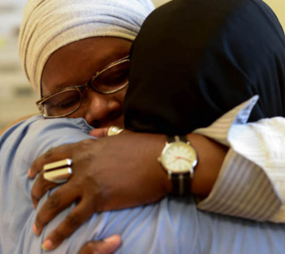 This blog was written by Intake Coordinator Intern, Samantha Kayne.
This blog was written by Intake Coordinator Intern, Samantha Kayne.
Since the 1980s, the number of incarcerated women has increased dramatically leading to a rise in the number of women, many of whom are mothers, reentering society.1 Unfortunately, reentry is far from successful, with more than half of formerly-incarcerated women rearrested within 3 years of release. Therefore, it is critical to understand the barriers that women face to successful reentry and what we can do about them. Reentry is challenging for many reasons, including inadequate funding for programs to help women transition from prison to society and the fact that many women return to communities lacking in opportunities and resources. Arguably the most significant barrier to successful reentry is the stigma associated with conviction and incarceration. Stigma is defined as a set of negative and often unfair beliefs that a society or group of people have about something. All formerly-incarcerated people are forced to suffer this stigma, but it is harsher for women because of gender-based stereotypes and additional burdens placed upon them as a result.
Legal sanctions make it difficult for the formerly incarcerated to enter the workforce and restrict opportunities for obtaining public assistance. Some laws prevent people reentering society from obtaining an occupational license, such as a real estate or medical license. Other laws ban employers such as nursing homes, daycare centers and other service occupations that tend to be more female-dominated from hiring people convicted of certain offenses. These barriers have a disproportionately negative impact on women and people of color, and contradict evidence indicating that the formerly incarcerated can be more reliable employees than people without records. Reentering citizens also face barriers to obtaining loans, driver’s licenses, enrolling in college, and securing child custody. And people with felony convictions can be banned from voting, further marginalizing women’s participation and relevance in society.
Women reentering society also suffer social stigma in the form of negative attitudes and discrimination from society more broadly. The formerly incarcerated “are often viewed with contempt, perceived as threatening, or considered to have failed as citizens.” This social stigma further limits employment and housing opportunities and causes separation from family. Living with their children or having access to childcare and other supportive services are typically not options available to women while they transition to full reentry. Separation from family and community makes reentry even more difficult by compromising women’s ability to seek help and obtain employment, housing and health care.
Having a strong, supportive network is critical for successful reintegration. Yet, the effect of stigma can significantly contribute to negative self-esteem and limit the amount of interaction the formerly incarcerated have with people who could be their social network. Former prisoners recognize that their community shuns them and subjects them to restraints from success. Pervasive negative stereotypes exacerbate women’s underlying mental health conditions and cause internalization of feelings of worthlessness, which diminishes former prisoners’ expectations for their successful reentry and often becomes a self-fulfilling prophecy.
Solutions to Combat Reentry Stigma
Government action is required to change laws that perpetually punish those who have already done their time. For example, state governments should enact occupational licensing reform and allow all ex-offenders to vote. Ohio and the city of Cincinnati government employers have “banned the box” but private employers should be prohibited from using criminal history when considering job applicants. More funding should be directed to reentry programs including cognitive programs that use psychology to help mindset change, and programs that create support networks for women, like Dress for Success. Measures like these would help push society to move past the stigma of a criminal record, lead to less rearrests and help communities thrive.
Work Cited
Couloute, Lucius, and Daniel Kopf. “Out of Prison & Out of Work: Unemployment among formerly incarcerated people.” Prison Policy Initiative, https://www.prisonpolicy.org/reports/outofwork.html. Accessed 19 January 2023.
Doyle, David Matthew, and Lisa Molix. “How does stigma spoil relationships? Evidence that perceived discrimination harms romantic relationship quality through impaired self-image.” Journal of Applied Social Psychology, vol. 44, no. 9, 2014, pp. 600-610.
Frankel, Amy, and Elizabeth DePoy. “Thoughts Beyond Stigma-Implications for Change Reflected in the Voices of Previously Incarcerated Citizens.” CrimRxiv, 14 November 2021, https://www.crimrxiv.com/pub/a1snady0/release/1. Accessed 26 January 2023.
Monazzam, Niki, and Kristen M. Budd. “Incarcerated Women and Girls – The Sentencing Project.” The Sentencing Project, 3 April 2023, https://www.sentencingproject.org/fact-sheet/incarcerated-women-and-girls/. Accessed 7 July 2023.
Moore, Kelly, et al. “The Self-Stigma Process in Criminal Offenders.” NCBI, 17 October 2016, https://www.ncbi.nlm.nih.gov/pmc/articles/PMC5067087/. Accessed 26 February 2023.
Nair, Anjali, and Keri Blakinger. “Banned From Jobs: People Released From Prison Fight Laws That Keep Punishing Them.” The Marshall Project, 2 December 2021, https://www.themarshallproject.org/2021/12/02/banned-from-jobs-people-released-from-prison-fight-laws-that-keep-punishing-them. Accessed 26 February 2023.
Park, Nicholas, and Grant Tietjen. “It’s Not a Conversation Starter.” Or is it?: Stigma Management Strategies of the Formerly Incarcerated in Personal and Occupational Settings.” Qualitative Criminology, vol. 10, no. 3, 2021, https://www.qualitativecriminology.com/pub/kd7uo6o1/release/1. Accessed 25 January 2023.
Russ, Ebony, et al. “Prison And Jail Reentry And Health.” Health Affairs, 28 October 2021, https://www.healthaffairs.org/do/10.1377/hpb20210928.343531/. Accessed 26 February 2023.
Sawyer, Wendy. “Who's helping the 1.9 million women released from prisons and jails each year?” Prison Policy Initiative, 19 July 2019, https://www.prisonpolicy.org/blog/2019/07/19/reentry/. Accessed 7 July 2023.
Sheppard, Amy, and Rosemary Ricciardelli. “Employment after prison: Navigating conditions of precarity and stigma.” European Journal of Probation, vol. 12, no. 1, 2020. Sage Journals, https://journals.sagepub.com/doi/full/10.1177/2066220320908251. Accessed 26 February 2023.
Tripodi, Stephen, et al. “Pathways to Recidivism for Women Released From Prison: A Mediated Model of Abuse, Mental Health Issues, and Substance Use.” Criminal Justice and Behavior, vol. 46, no. 9, 2019. Sage Journals, https://journals.sagepub.com/doi/10.1177/0093854819867119#:~:text=Multistate%20recidivism%20analyses%20suggest%20that,%2C%20%26%20Crow%2C%202007). Accessed 07 07 2023.
van Olphen, Juliana, et al. “Nowhere to go: How stigma limits the options of female drug users after release from jail.” Substance Abuse Treatment, Prevention, and Policy, vol. 4, no. 10, 2009. PubMed Central, https://www.ncbi.nlm.nih.gov/pmc/articles/PMC2685368/. Accessed 07 07 2023.